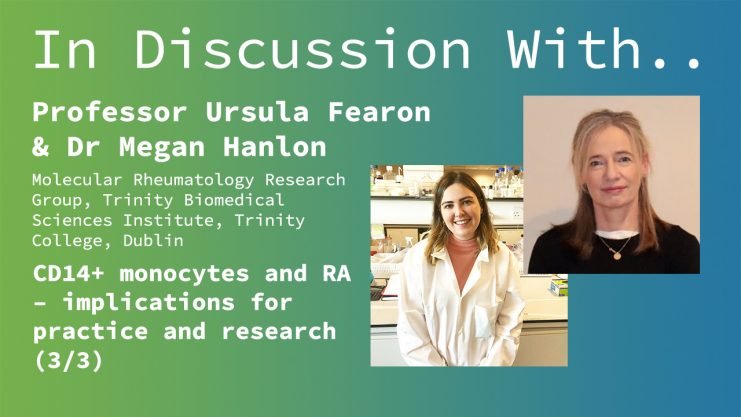Advertisment
CD14+ monocytes and RA – implications for practice and research

Interview and article by Christine Clark.
Dr Megan Hanlon and Professor Ursula Fearon describe the implications of their research findings for future practice and research in rheumatoid arthritis.
Once it had been shown that circulating monocytes in rheumatoid arthritis (RA) patients were somehow primed to produce pro-inflammatory mediators and also had a hypermetabolic phenotype, reliant on glycolytic mechanisms and regulated by STAT3, the next important question was, ‘how early in the course of the disease does this occur?’. To answer the question the researchers turned to the individuals at risk (IAR) – the individuals who have no clinical signs of RA but are known to have an increased risk of developing the disease.
“Really what was so striking here was that we were seeing that this hypermetabolic phenotype actually precedes clinical manifestations and we can see the stepwise increase from healthy controls through IAR to RA in our inflammatory panel. Actually….. what was really interesting was that the metabolic capacity of these cells was extremely similar to RA and again, this precedes clinical manifestations [of disease]. The metabolic profiles of IAR and RA monocytes are “nearly indistinguishable”, she adds.
The final investigation in this study involved examination of the site of inflammation –the synovial tissue. “Again we were able to see this enrichment of this monocytic pathway genes in individuals at risk and in RA, in comparison to healthy synovium”, says Dr Hanlon.
This is the first study that has shown that characteristic metabolic changes in circulating monocytes precede the clinical manifestations of RA. Further study of the IAR group may provide important clues or insights into the evolution of RA as a disease. In addition, it may be possible to identify patients at high risk of developing RA and also those who are likely to respond to treatment.
Implications for drug development
In the past, patients with chronic rheumatoid arthritis did not receive treatment until the disease was at an advanced stage. Within five years they had functional disability and within 10 years the majority had given up work because of their increasing functional disability. Over the past 20 years new drugs and early treatment have improved this situation considerably, but there is still room for further improvement. “With RA patients at the moment what we have is one third of patients respond great to treatment, a third have sub-optimal responses with side effects and a third of patients don’t respond at all”, says Professor Fearon.
In practice, a patient may not receive the most effective treatment in time. “What happens to patients is they go into a clinic, they get a therapy, they might fail and get a second, they might fail that therapy and by the time they get to the third or fourth therapy they have developed destruction in their joints and it’s irreversible. So, what we want to do is to be able to give patients the right treatment on the day they arrive into the clinic at the very beginning. We know the earlier we treat patients the less chance they have of getting irreversible damage”, say Professor Fearon.
The importance of this study is that it has identified a circulating biomarker that will allow identification of individuals who are at high risk of developing RA.
“What this study has shown is that the signature that we’re finding in the blood –which we could do in the clinic – seems to be reflective of those macrophages in the tissue so we’re hoping that if we expand his study to a larger cohort of rheumatoid [arthritis] patients that it might help us to figure out what patients will respond to treatment or not and a particular treatment. The second [implication] is that we are going to be monitoring the signature in those patients who are at risk and that the minute they start to show signs of rheumatoid arthritis that we can treat them early and stop that irreversible damage”, explains Professor Fearon.
The final implication is important for the one third of patients who do not respond to any current therapies. Targeting the ‘metabolic switch’ in monocytes could be a way to ‘turn off’ the monocytes and thereby turn off the inflammation.
“The key message is that we want to find new therapeutic targets for patients that don’t respond and the earlier we can treat patients the better their responses are, and we might achieve the mission in more patients”, concludes Professor Fearon.
Read and watch the full series on our website or on YouTube.
Professor Ursula Fearon is Head of Molecular Rheumatology in the Trinity Biosciences Institute in Trinity College Dublin. This research group is focused on investigating the pathogenic mechanisms involved in driving autoimmune diseases, specifically rheumatoid arthritis and psoriatic arthritis.
Dr Megan Hanlon is a post-doctoral research fellow in Professor Fearon’s molecular rheumatology research group. Her PhD and post-doctoral research is focused on the myeloid compartment of the synovial joints, specifically monocytes and macrophages.
Rheumatoid arthritis CD14+ monocytes display metabolic and inflammatory dysfunction, a phenotype that precedes clinical manifestation of disease. McGarry T, Hanlon M, Marzaioli V et al. Clin Transl Immunol 2021;10: e1237





